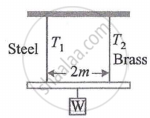Advertisements
Advertisements
प्रश्न
Choose the correct option:
A body of mass 1 kg is performing linear S.H.M. Its displacement x (cm) at t(second) is given by x = 6 sin `(100t + π/4)`. Maximum kinetic energy of the body is ______.
पर्याय
36J
9J
27J
18J
उत्तर
A body of mass 1 kg is performing linear S.H.M. Its displacement x (cm) at t(second) is given by x = 6 sin `(100t + π/4)`. Maximum kinetic energy of the body is 18J.
Explanation:
Express the relation for the displacement of a body executing S.H.M.
`x = A sin(omega t + phi)` ......(1)
Here, x is the displacement, `omega` is the angular speed, t is the time in seconds, `phi` is the initial phase of the particle executing S.H.M.
The displacement of a body x(cm) at t(second) is given by,
`x = 6sin(100t + pi/4)` ....(2)
Comparing equation (2) with (1),
`omega = 100`rads–1, `phi = pi/4` and A = `(6 cm xx (10^-2 m)/(1 cm))`
A = `6 xx 10^-2` m
Express the relation for the velocity of a body executing S.H.M.
`v = omegasqrt(A^2 - x^2)` .....(3)
Here, v is the velocity of the body.
Express the relation for the kinetic energy of a body executing S.H.M.
`E_k = 1/2 mv^2` .....(4)
Here, m is the mass of the body.
Substitute value of v from equation (3) in (4),
`E_k = 1/2 m(omegasqrt(A^2 - x^2))^2`
= `1/2 momega^2 (A^2 - x^2)` .....(5)
The kinetic energy is maximum at the mean position, x = 0.
Substitute x = 0, m = 1 kg, `omega = 100`rads–1, and A = `6 xx 10^-2` m in equation (5).
`E_k = 1/2 momega^2 A^2`
= `1/2 xx 1 kg xx ((100"rad")/s)^2 x (6 xx 10^-2 m)^2`
= 18J
Hence, the maximum kinetic energy of the body is 18J.
APPEARS IN
संबंधित प्रश्न
Show that a linear S.H.M. is the projection of a U.C.M. along any of its diameter.
Define linear simple harmonic motion.
What does the phase of π/2 indicate in linear S.H.M.?
Define linear S.H.M.
The equation of a simple harmonic motion is given by, x = 8 sin (8πt) + 6 cos (8πt), the initial phase angle is ______
At extreme positions of a particle executing simple harmonic motion, ______
In a spring-block system, length of the spring is increased by 5%. The time period will ____________.
A particle is performing a linear simple harmonic motion of amplitude 'A'. When it is midway between its mean and extreme position, the magnitudes of its velocity and acceleration are equal. What is the periodic time of the motion?
A particle executes simple harmonic motion and is located at x = a, b, and c at times t0, 2t0, and 3t0 respectively. The frequency of the oscillation is ______.
A particle is executing simple harmonic motion with frequency f. The frequency at which its kinetic energy changes into potential energy is ______.
For a particle executing simple harmonic motion, which of the following statements is NOT correct?
The velocities of a particle performing linear S.H.M are 0.13 m/s and 0.12 m/s, when it is at 0.12 m and 0.13 m from the mean position respectively. If the body starts from mean position, the equation of motion is ____________.
A particle executes simple harmonic motion with amplitude 'A' and period 'T'. If it is halfway between mean position and extreme position, then its speed at that point is ______.
The equation of a particle executing simple harmonic motion is given by x = sin π `("t" + 1/3)` m. At t = 1s, the speed of particle will be ______. (Given π = 3.14)
Two simple harmonic motions are represented by the equations y1 = 0.1 sin `(100pi"t"+pi/3)` and y1 = 0.1 cos πt.
The phase difference of the velocity of particle 1 with respect to the velocity of particle 2 is ______.
A particle is executing simple harmonic motion with amplitude A. When the ratio of its kinetic energy to the potential energy is `1/4`, its displacement from its mean position is ______.
A light rod of length 2m suspended from the ceiling horizontally by means of two vertical wires of equal length. A weight W is hung from a light rod as shown in figure.

The rod hung by means of a steel wire of cross-sectional area A1 = 0.1 cm2 and brass wire of cross-sectional area A2 = 0.2 cm2. To have equal stress in both wires, T1/T2 = ______.
If a body is executing simple harmonic motion, then ______.
Two simple harmonic motion are represented by the equations, y1 = 10 sin `(3pi"t"+pi/4)` and y2 = 5`(3sin3pi"t"+sqrt3cos3pi"t")`. Their amplitudes are in the ratio of ______.
What do you know about restoring force?
The displacement of a particle performing simple harmonic motion is `1/3` rd of its amplitude. What fraction of total energy will be its kinetic energy?
